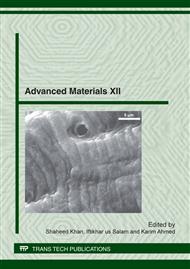p.284
p.293
p.301
p.307
p.315
p.321
p.330
p.335
p.343
Single Step Heat Treatment Cycle for Development of Isotropic Fe-Cr-Co Magnets
Abstract:
This study is focused on the development of isotropic Fe-Cr-Co based permanent magnets. Two compositions Fe-25Co-30Cr-3.5Mo-0.8Ti-0.8 and Fe-24 Co-32Cr-0.5Si-0.8V-0.8Ti were tried to optimize by adjusting heat treatment cycle. A modified single step heat treatment cycle was established which made processing easy and quick. Alloys were prepared in tri-arc melting furnace under inert atmosphere of Argon. Samples were solution treated at 1250 °C for 5 hours followed by water quenching. Then a spinodal decomposition heat treatment cycle in the temperature range 620 645 °C was applied in order to produce magnetism in this material. Samples were characterized for metallographic, chemical, structural and magnetic properties using Optical microscope, Scanning electron microscope equipped with Energy dispersive spectrometer, X-ray diffractometer and DC magnetometer. This study reveals that magnetic properties are sensitive to the spinodal decomposition temperature. Only + 5 °C change in temperature from optimum temperature can cause remarkable attenuation in magnetic properties. Magnetic properties of the alloys were achieved by controlling the spinodal decomposition temperature and subsequent cooling rate. The best magnetic properties in Mo and V containing alloys were obtained as 880 Oe (Hc), 7960 G (Br), 2.3 MGOe (BHmax) and 700 Oe (Hc), 7750 G (Br), 1.8 MGOe (BHmax), respectively.
Info:
Periodical:
Pages:
315-320
Citation:
Online since:
May 2012
Authors:
Keywords:
Price:
Сopyright:
© 2012 Trans Tech Publications Ltd. All Rights Reserved
Share:
Citation:


